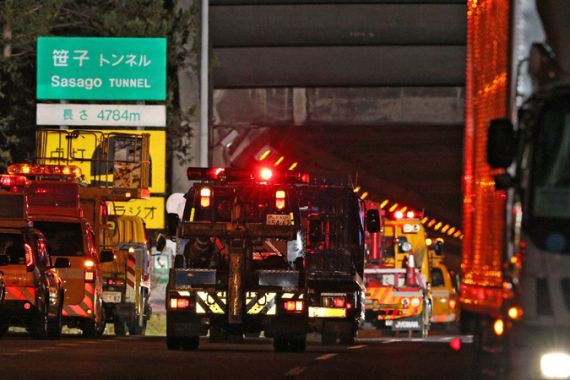Japan orders tunnel checks after disaster
Thorough review of ageing highway structures pledged as death toll from tragedy at Chuo Expressway rises to nine.

Japan has ordered inspections of ageing highway tunnels after a collapse in Yamanashi prefecture that killed nine people, as suspicion over the cause of the accident centred on decaying ceiling supports.
The government pledged a thorough review on Monday and said “significant investment” would probably be required in the motorway network, parts of which, including the accident site, were built during the economic boom of the 1960s and 1970s.
Keep reading
list of 4 itemsLost Futures
Photos: Greek valley that became a lake stirs drought debate
Botswana threatens to send 20,000 elephants to Germany
“As a major factor, we suspect ageing,” an official from highway operator NEXCO said, referring to the tragedy at the Chuo Expressway’s Sasago tunnel, which passes through hills near Mount Fuji, 80km west of Tokyo.
Footage from inside the tunnel showed concrete panels had collapsed in a V-shape, possibly indicating some kind of weakness in the central supporting pillars suspended from the roof, experts said.
Engineers on Monday began inspections at three other tunnels in the region with the same design, as well as at Sasago.
Rescuers earlier found three more crushed bodies, taking the death toll to nine. At least three vehicles were buried on Sunday when concrete ceiling panels crashed down inside the nearly 5km tunnel.
Five blackened bodies were found inside a single vehicle and emergency workers also recovered the body of a lorry driver, identified by broadcaster NHK as Tatsuya Nakagawa, 50, who had telephoned his company to ask for help.
Later, the bodies of an elderly man and two elderly women were also recovered from a crushed vehicle, Kyodo News said, as attention turned to what caused the collapse.
Deterioration suspected
An official from highways operator NEXCO said material degradation was a possibility, adding the risk of further collapse remained although the ceiling had undergone its regular five-yearly inspection in September this year.
Chikaosa Tanimoto, professor emeritus of tunnel engineering at Osaka University, told that NHK the support panels were suspended from pillars.
“It is conceivable that the parts connecting the ceiling panels and pillars, or pillars themselves, have deteriorated, affected by vibrations from earthquakes and passing vehicles,” he said.
Earthquakes are common in Japan, though none was reported in the area at the time of the collapse.
Emergency workers equipped with breathing apparatus on Sunday battled around a third of the way into the tunnel, where they found 110 metres of concrete panels had fallen, crushing several vehicles.
But hours later engineers gave warning the structure could be unstable, forcing rescuers to halt their work as a team of experts assessed the danger.
Dozens of people on Sunday abandoned their vehicles on the Tokyo-bound section of carriageway, and ran for the exits where they huddled in bitter winter weather.
Japan has an extensive web of highways with thousands of tunnels, usually several hundred metres long. Millions of cars use the network every day.